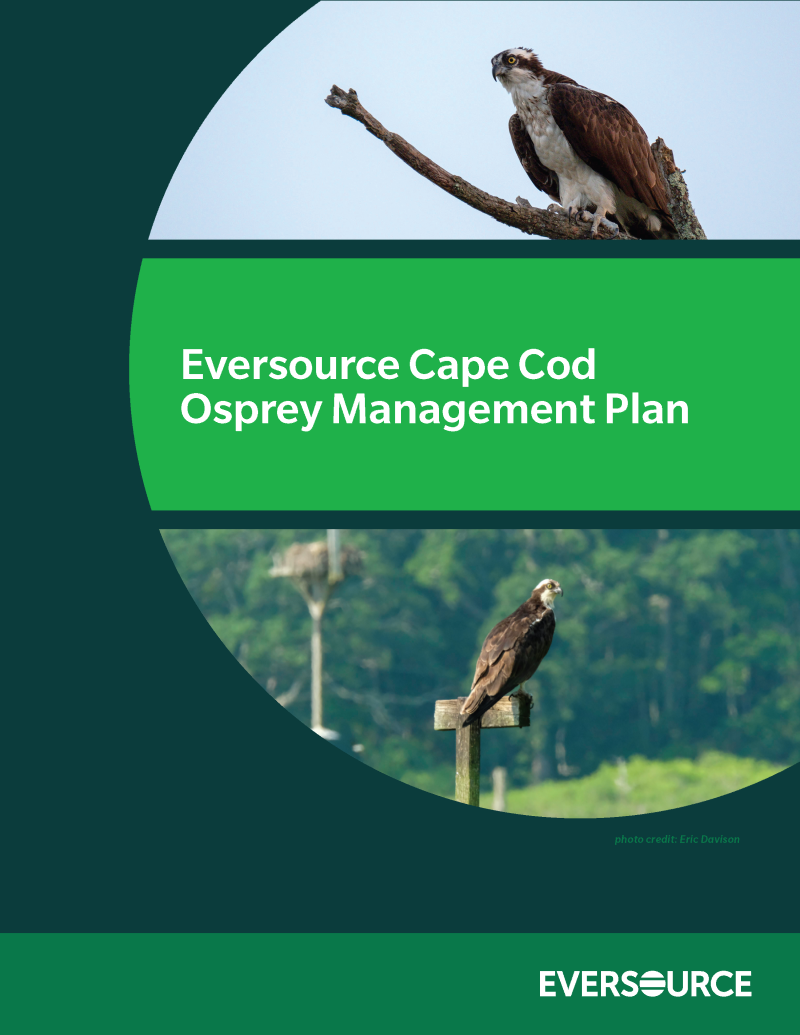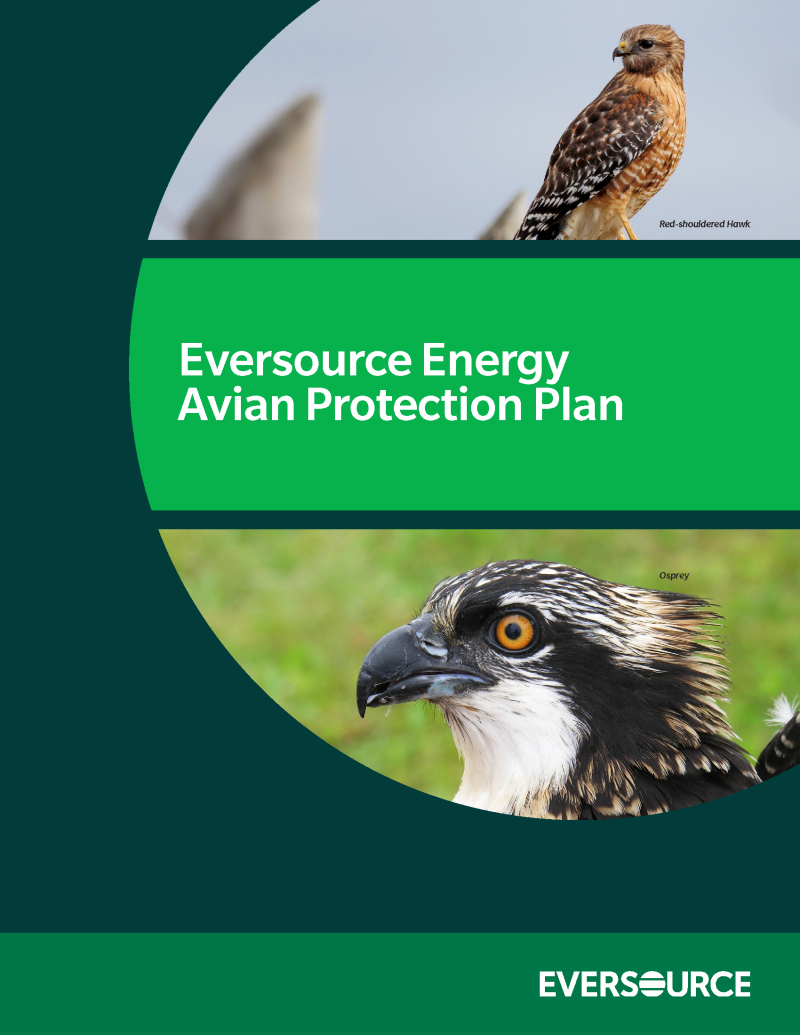Information on this page is for customers in
{{ town-name }}
Osprey Management and Bird Protection
Working to keep birds safe and protect our critical infrastructure
Report a Nest on a Utility Pole
Utility infrastructure can look tempting for some species of birds, particularly osprey. However, nesting or perching on poles can lead to hazards like fires, cause reliability issues like power outages, and can be dangerous for the birds.
To help us keep wildlife safe and power reliable, please report any nests or obstructions to osprey@eversource.com. If the pole is easily and safety accessible, include the pole number (located on a placard on the pole near eye level) and the nearest address to the pole.
If a nest is on fire
Call 911 immediately and do not go near the pole. Dispatchers will contact us directly to ensure the fire can be extinguished safely.
Cape Cod Osprey Management Plan

Given the abundance of osprey nesting on our utility poles on Cape Cod, we developed the Cape Cod Osprey Management Plan to:
- Reduce osprey-related outages and service interruptions
- Discourage osprey from nesting on our infrastructure
- Decrease utility-associated osprey injuries and fatalities
- Improve processes related to osprey nest management
We collaborated with Mass Audubon, Wild Care Inc., New England Wildlife Center and local municipalities on Cape Cod to create this plan, and we work closely with stakeholders during osprey nesting season.
Avian Protection Plan

We're committed to improving reliability, reducing risks to bird safety and maintaining regulatory compliance in our day-to-day activities. Our Avian Protection Plan:
- Provides a summary of regulations involving birds
- Outlines roles and responsibilities of staff
- Guides employees on procedures for managing bird issues and nests
- Provides information on bird species that could be encountered on our system
Frequently Asked Questions
Why does Eversource remove osprey nests from poles?
We remove most osprey nests from our distribution line poles to protect both the osprey and the electric delivery system.
Unoccupied nests (where no eggs or chicks are present) are removed when they present a threat to the continued reliability of the electric system. Nests are removed to:
- Prevent future outages, electrocutions, and fires
- Inspect the underlying crossarms and equipment
- Repair any damage that may have resulted
- If possible, install a nesting deterrent to prevent rebuilding of the nest at that location
When a nest is occupied (where there are eggs or chicks present), except for instances of imminent danger (see below), we will leave the nest in place until the chicks have left the nest.
To minimize risk to an occupied nest:
- Any low-hanging nest material will be trimmed
- Insulators will be placed on the energized equipment below to minimize the risk of future outages or harm to the nest, eggs and/or chicks
It is important to note that insulation is a temporary measure and is not intended for permanent installation. Insulation is vulnerable to high-winds and degradation from ultra-violet rays.
If the nest is in imminent danger because equipment cannot be insulated and/or nest material cannot be trimmed, our crews will follow the procedures outlined in the Cape Cod Osprey Management Plan and Eversource’s Special Purpose Utility Permit granted by the U.S. Fish and Wildlife Service.
We follow strict guidelines set by the United States Fish and Wildlife Service and Massachusetts Division of Fisheries and Wildlife when it comes to maintaining our electric system around osprey nests.
Why can't Eversource install more platforms where osprey can safely nest on the poles?
We focus on keeping ospreys off our infrastructure in a manner that is safest for the birds and in accordance with regulations. Although installation of platforms may sound like an easy fix, there are many factors involved with installation of a platform, including:
- Who owns the property where the pole is located? We typically only have an easement for the utility line. The underlying property owner may refuse installation of a platform because it will encourage osprey nesting. This is most common on residential properties or certain roadsides where osprey will drop discarded prey, sticks and other debris from the nest.
- Is the orientation of equipment on the pole suitable to facilitate a platform? A distribution pole often carries more than the power lines. Fuses, insulators, transformers, relays and switches are all equipment commonly mounted to the pole and/or crossarms. Depending on the orientation and amount of equipment, there may not be space.
- Can the pole handle the weight of the platform? Distribution poles are engineered to hold electric infrastructure. Platforms can weigh several hundred pounds which may be more additional weight than the pole can handle. The structure needs to be evaluated to see if and what type of platform can be installed.
- Will there be any objection to the installation of a platform? Although many people are inspired by osprey, it’s important to remember that this feeling is not shared by all. Osprey and their nests are smelly (from the prey they consume to their excrement) and noisy (as they call to mates and protect their territory). Before a platform can be installed, we need to evaluate the surrounding area to ensure we’re not creating a nuisance for local residents or stakeholders.
Can Eversource install more platforms located off utility poles?
We try to focus our efforts on what can be done within our right-of-way on the utility poles themselves. We can't install nesting platforms outside of our easement for several reasons, including access restrictions, property rights, liability concerns, maintenance of the platform and limited construction staff and resources.
Can Eversource remove a nest with osprey chicks or eggs?
A nest with eggs and/or chicks present can only be removed if the life or viability of an osprey chick or eggs is immediately threatened by the nest’s continued presence on the utility structure.
Should a nest with eggs and/or chicks need to be removed, we are permitted under our Special Purpose Utility Permit to either relocate the nest to a suitable location or to rehome the eggs and/or chicks with a wildlife rehabilitator where they can be reared and released back into the wild. We always notify U.S. Fish and Wildlife Service to ensure regulatory compliance. We also work with local wildlife rehabilitators for proper care of chicks and/or eggs.
If the nest is not in immediate danger, the energized equipment on the pole will be insulated to protect from possible fire and power outage. Once the chicks have fledged and the osprey migrated to their wintering ground, the nest will be removed, and a deterrent installed.
Where did all the osprey go?
Osprey are a migratory species, meaning that each fall, typically sometime in September, they leave New England and travel to their over-wintering grounds in Central and South America, though some will overwinter in parts of Florida and southern California. Once spring comes around the following year, the osprey will return north and begin building their nests. However, during the fall and winter, when osprey are in their overwintering grounds, Eversource focuses on removing the empty nests to inspect the poles and equipment and install deterrents. When the osprey return, they find a new and safer location where they can establish their nest.
How come the young are not leaving the nest?
Sometimes, just like young humans, young osprey have trouble leaving the safety, comfort and security of their home (nest) where they’ve been cared for and fed by their parents. But in time, they’ll realize that they need to begin fending for themselves and will eventually leave the nest and make their way to their overwintering grounds. Seeing young chicks in the nest alone is not necessarily cause for alarm, particularly in late August and early September when the birds are preparing to migrate.